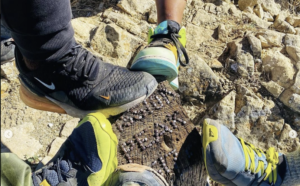The single-track trail along the creek looks quite inviting: just wide enough for hiking, with no fallen limbs or nasty briars sticking out, a canopy overhead. It all seems so natural. But Melvin Johnson knows better. As operations coordinator for the East Bay Conservation Corps, he oversees a dozen crews that maintain trails in the hills, shore up washouts, and clear away brush. Founded in 1983, EBCC combines two great community services into one nonprofit: the education of young people and the maintenance of hundreds of miles of trails on lands owned by the East Bay Regional Park District, the water districts, and other agencies.
BN: Who works with you at EBCC?
MJ: We got kids from 17 to 24, all nationalities. Some come from the criminal justice system where they’re on probation, some by word of mouth. Some of them have been on the streets for a long time and aren’t making any headway. We’re a charter school and we emphasize education first, especially for kids who need GEDs. We can teach them a trade, so they can build themselves up with work skills. Then they can go into occupations like landscaping, or tree cutting. It’s about getting them to be more productive in the community.
BN: What skills did you bring to this job?
MJ: I got a lot of mechanic skills, working with power tools. I also love being out in the woods. When I was hired in 1999, I went up to the grade [work site] and found everything they did was what I did as a young boy. I’d lived in the Louisiana backcountry all my life.
BN: Does EBCC build new trails as well as maintain old ones?
MJ: It depends. Sometimes we have to build a new trail around a washout area. Recently in Morgan Territory, east of Mount Diablo, we had to get a trail down the bank, across a big creek, and up to the other side. The park rangers started the plan and we helped them out. Within the parks, the main work is maintaining the trails, especially in late summer and early winter. They have a lot of ruts and places where they’re washed out. Trees fall over the trails. One challenge is to keep it neat but not to prune or “weed-eat” too much because some people get touchy about certain plants and trees. When people don’t want us to cut certain things, we leave them in there, even the poison oak. It’s always an education on the grade for the crews because they’re learning to identify plants, trees, and animal tracks, and how to cut plants so you don’t kill them.
BN: Most hikers don’t have a clue how much work goes into maintaining trails. How do you approach the job?
MJ: We like to leave as much of the canopy as possible. When you hike in a shady area, even just 10 yards long, it cools you off so that you can walk into the sunny area again for another mile. We start by looking for wet places that are usually in the shady parts of trails. You try to use the materials right there on the trail as much as possible so what you build won’t look out of place. We use limbs from nearby trees and logs from a fallen tree. Often when one tree falls, it takes out other trees with it. The best material is what’s there on the ground. If a tree is half broken off, we might use it as a landmark. We’ll take dirt from a trail that’s slid down a bank and use it to shore up the sides of the new trail.
Water bars—those are trenches that cross the trail at a 45-degree angle with a dirt mound built up at the meeting with the trail—need to be rebuilt so the trail keeps drained and dry. When the water comes down a slope, it will go naturally into the trench and then when it hits the hump, it’ll continue to go across the trail and down the other side.
BN: Have you seen much wildlife?
MJ: We’ve seen mountain lions up at Contra Loma [near Antioch] and Del Valle [near Livermore]. We’ve seen baby bobcats and know that Mom is somewhere around. Lots of snakes, many friendly, but some poisonous, like rattle-snakes. Wood rats, tarantulas, scorpions in Don Castro [in Hayward]. Wild hogs, turkeys, skunks, squirrels, raccoons. There’s a pack of wild dogs in Morgan Territory.
BN: Do hikers and other park visitors appreciate what you do?
MJ: People will thank you for keeping things in good shape. It becomes a community thing. Someone might say, “We like the way you did the entrance.” The visitors to the park will often let us know where there’s a tree down on a trail. We welcome all kinds of feedback.
BN: You led your crew, number C1, for six years, but you were just promoted from crew leader to operations manager. Will you miss being outdoors so much?
MJ: I still get a chance to supervise what’s going on at the work sites, so I get out a bit. The woods gives you job security. They’re always going to be there, needing maintenance.

.jpg)



